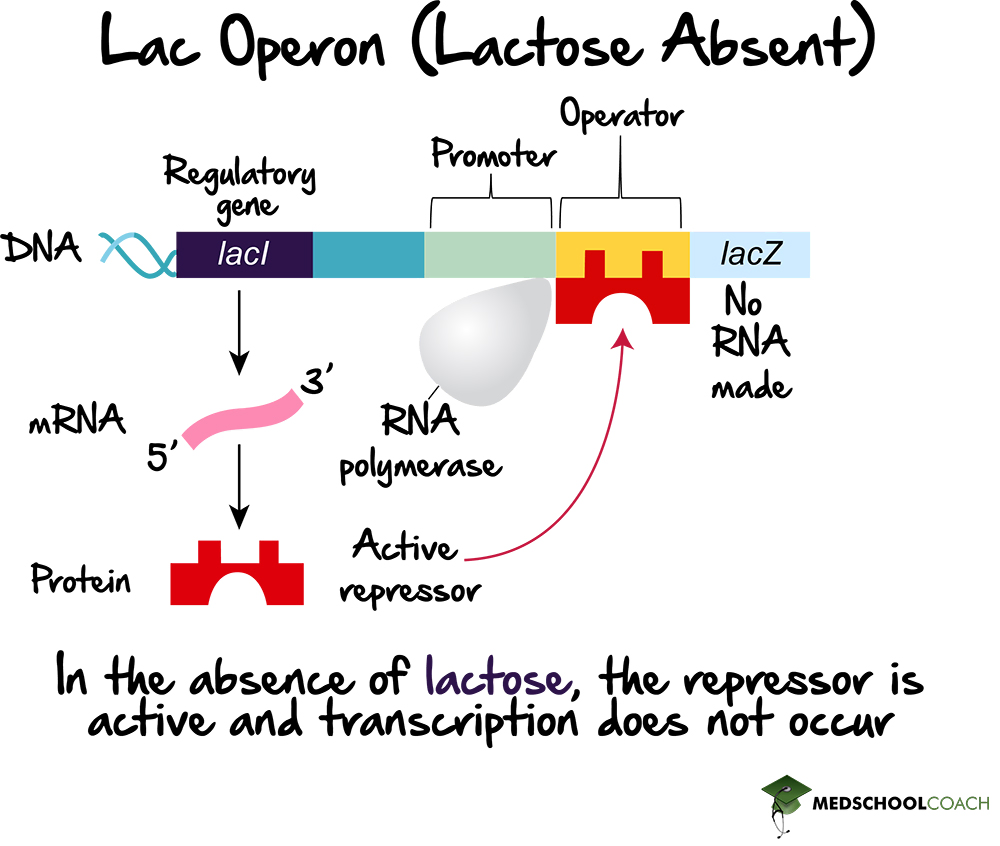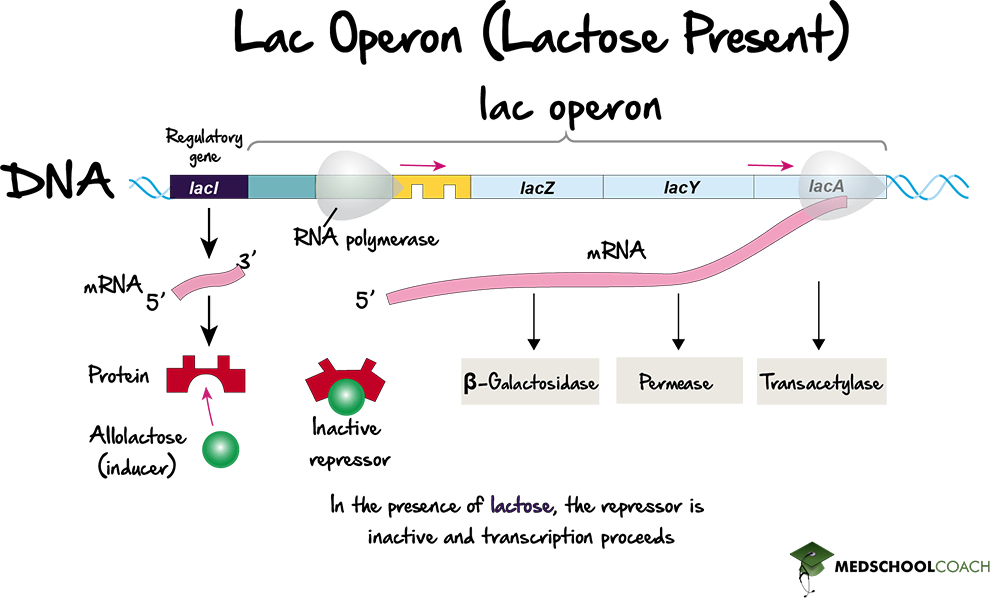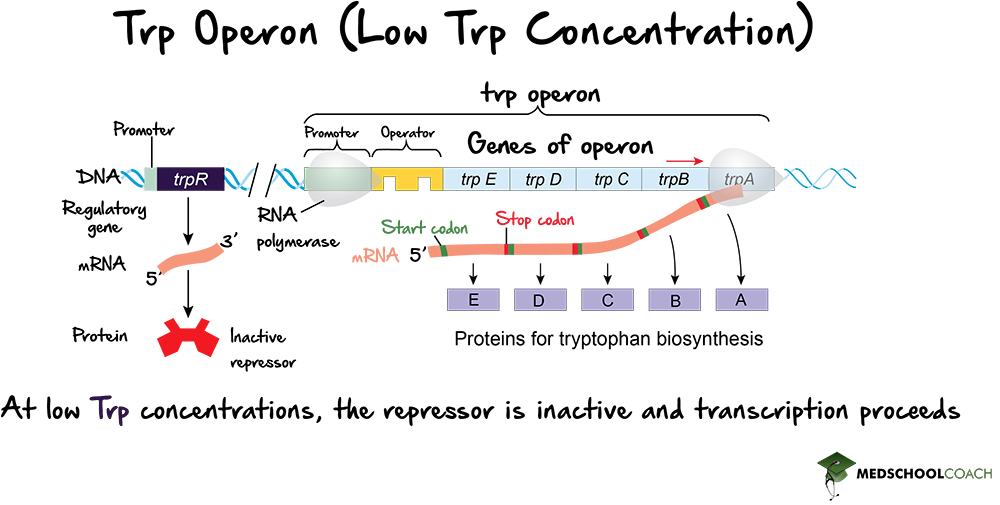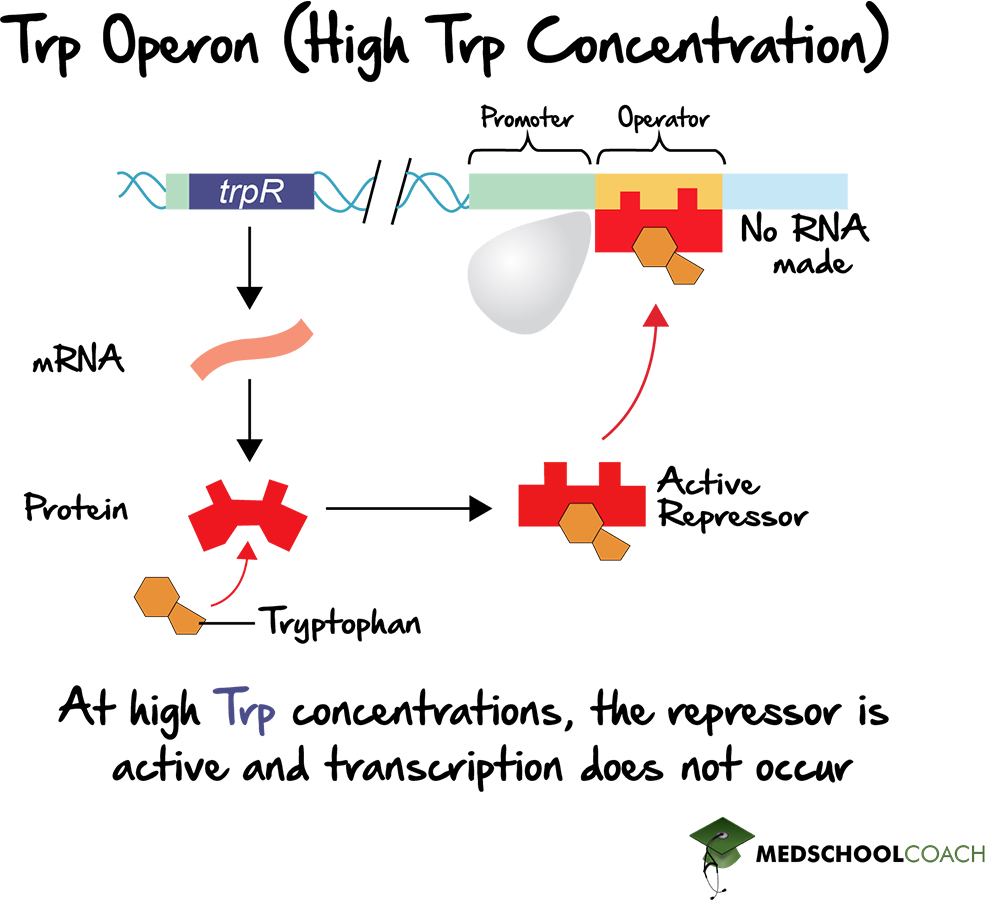Operons & Prokaryotic Gene Expression Part 1
MCAT Biology - Chapter 2 - Section 2.1 - Gene Expression - Operons & Prokaryotic Gene Expression Part 1
- Home
- »
- MCAT Masterclass
- »
- Biological and Biochemical Foundations of Living Systems
- »
- Biology
- »
- Operons & Prokaryotic Gene Expression Part 1 – MCAT Biology
Sample MCAT Question - Operons & Prokaryotic Gene Expression Part 1
Which of the following describes polycistronic mRNA?
a) It codes for only a single protein
b) It is present in eukaryotes
c) It is transcribed from a single gene
d) It is present in prokaryotes
D is correct.
Prokaryotic mRNA is polycistronic, meaning multiple protein products are coded by each mRNA molecule. On the other hand, eukaryotic mRNA is monocistronic, meaning each mRNA contains the coding sequence for one protein.
Get 1-on-1 MCAT Tutoring From a Specialist
With MCAT tutoring from MedSchoolCoach, we are committed to help you prepare, excel, and optimize your ideal score on the MCAT exam.
For each student we work with, we learn about their learning style, content knowledge, and goals. We match them with the most suitable tutor and conduct online sessions that make them feel as if they are in the classroom. Each session is recorded, plus with access to whiteboard notes. We focus on high-yield topics if you’re pressed for time. If you have more time or high-score goals, we meticulously cover the entire MCAT syllabus.
Intro to Operons & Prokaryotic Gene Expression
Understanding prokaryotic gene expression is essential for the MCAT exam. In prokaryotes, gene expression is tightly regulated. Structural proteins that have related functions are encoded together within the genome in various blocks called operons. An operon is a DNA sequence that includes a promoter, an operator, and the genes that are regulated together. The promoter is a DNA sequence that is recognized by RNA polymerase for transcription. The operator is a DNA sequence that a repressor can bind to, and repressors are proteins that can either allow or inhibit transcription. The set of genes in an operon are transcribed together by way of the promoter, creating a polycistronic transcript. In other words, multiple proteins are encoded by a single mRNA molecule.
In many ways, prokaryotic gene regulation through the use of an operon is extremely efficient. In order to carry out a particular biochemical process, instead of producing a separate mRNA for each protein or enzyme required for the process, prokaryotes can produce a single mRNA for all of the necessary proteins and enzymes in one nucleotide molecule.
Negative Control of Prokaryotic Gene Expression
Prokaryotic gene expression can be controlled in two ways: positive control and negative control. In negative control of prokaryotic gene expression, a repressor protein will bind to the operator. When this happens, RNA polymerase is blocked, so transcription cannot occur. However, the repressor protein is regulated as well. Whether or not the regulator protein will be able to bind to the operator depends on the presence or absence of an inducer molecule. An inducer molecule will bind to the repressor protein and alter its conformation. When the conformation of the repressor protein is changed, this will either allow or prevent the repressor protein from binding to the operator, so transcription can freely occur.
The Lac Operon
The lac operon is a negative inducible operon. It is ‘negative’ because it is under negative control, meaning it involves a repressor protein. ‘Inducible’ means that the lac operon is an operon whose transcription can be induced, or turned on, under the right conditions. The lac operon codes for proteins involved in the metabolism of lactose, and includes a promoter, an operator, and the genes for lactose metabolism. Initially, in the absence of lactose, the repressor protein is bound to the operator (Figure 1). When the repressor protein is in this position, it prevents RNA polymerase from transcribing the operon. In this way, no mRNA is produced.

However, if lactose is present, lactose will bind to the repressor (Figure 2). When this happens, the repressor will no longer be able to bind to the operator. In this way, RNA polymerase is free to transcribe the operon, resulting in the production of the enzymes for lactose metabolism. This process is quite logical. In the absence of lactose, the prokaryotic cell should not be making proteins and enzymes for lactose metabolism. However, in the presence of lactose, it would be beneficial for the cell to make proteins and enzymes for lactose metabolism.

The Trp Operon
The Trp Operon is a negative repressible operon. It is ‘negative’ because it is under negative control, meaning it involves a repressor protein. ‘Repressible’ means that the activity of this operon is usually on, and it can be repressed or turned off. The Trp operon encodes the proteins for tryptophan biosynthesis and has much the same structure as the lac operon, including a promoter, an operator, and all the genes for tryptophan biosynthesis. If tryptophan is at low concentrations in the cell, the repressor protein is inactive. In this way, the trp operon is transcribed, and the proteins for tryptophan biosynthesis are made (Figure 3).

However, at high concentrations of tryptophan, tryptophan itself acts as the repressor molecule and binds to the repressor protein (Figure 4). When the repressor protein binds tryptophan, the repressor protein undergoes a conformational change that allows it to bind to the operator. The binding of the repressor protein to the operator blocks RNA polymerase from transcribing the operon. In this way, the proteins and enzymes for tryptophan biosynthesis can no longer be generated.
Again, this process makes sense, given that tryptophan is an essential amino acid, and its production takes place within the cell. If the cell does not have enough tryptophan, then it should be able to make the enzymes to produce more. Likewise, if there is sufficient tryptophan or even too much tryptophan in the cell, then the tryptophan should act as a negative feedback regulator, and prevent transcription of mRNA for its production.

Explore More MCAT Masterclass Chapters
Take a closer look at our entire MCAT Masterclass or explore our Biochemistry lessons below.

One-on-One Tutoring
Are you ready to take your MCAT performance to a whole new level? Work with our 99th-percentile MCAT tutors to boost your score by 12 points or more!
See if MCAT Tutoring can help me
Talk to our enrollment team about MCAT Tutoring

MCAT Go Audio Course
Engaging audio learning to take your MCAT learning on the go, any time, any where. You'll be on the way to a higher MCAT score no matter where you are. Listen to over 200+ lessons.

MCAT Practice Exams
Practice makes perfect! Our mock exams coupled with thorough explanations and in-depth analytics help students understand exactly where they stand.

MCAT Prep App
Access hundreds of MCAT videos to help you study and raise your exam score. Augment your learning with expert-created flashcards and a question banks.